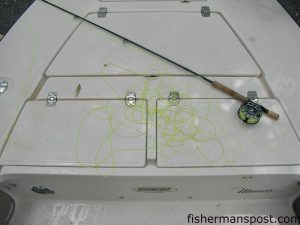Road To Redfish – Line Control
The afternoon that Gary Hurley and I picked to get out on the water and spend some time fly fishing (plenty of fishing but not much catching) presented a few of the usual obstacles one might encounter on any fly fishing trip: wind, the angle of the sun, tides, and the behavior of the fish itself. All of these factors contribute to strategy and the overall fish-ability of certain situations.
In my opinion, wind is one of the greatest challenges to overcome when fly fishing for reds in our area. It will affect the mood and location of the fish, as well as the ability to present the fly. In addition, the “tailing” reds that I hunt for are almost always found on windless days or at least against a substantial lee shore.
The first spot that Gary and I tried was a shallow bay not very protected from a 10-15 knot wind out of the east and the cast was difficult to say the least. Trying to punch the fly directly into the wind or having the wind blow towards your casting shoulder can severely affect distance, accuracy, and even safety (during a cast the hook is always better being blown away from the body).
So we opted to explore deep into one of our local creeks with the rising tide where the wind was blocked by tall trees and, therefore, became less of a factor. This enabled us to fish more efficiently by keeping our fly in the water in likely locations for more time, while also letting us break-down the whole process into its various parts.
Last time we talked about line management, and this week I would like to discuss what I call line control. When I am referring to line control, I am talking about line outside of the rod tip, and for this article we will concentrate on what to do with the line before a cast and after a retrieve.
Previously we talked about lines and tapers and the various lengths that will dictate how much line is needed to properly load the rod during a cast. False casting (keeping your back and forward casts up in the air to regulate line speed and line length) should be kept to a minimum to ensure maximum water time for your fly. Incorrect line length can spell the difference between having your equipment work for you and having your equipment work against you. And starting your cast with enough line to load the rod will do away with a lot of energy-wasting false casts.
Roll casting is used to lay out enough line in front of the caster to start a proper pick-up movement and backcast. It can be used to eliminate unnecessary backcasts and get your cast out quicker. Roll casting is accomplished by raising your rod vertically to get the line moving and then, in the same motion, casting your rod forward. This movement will essentially roll your fly line over and lay it out in front of you.
Water loading is another trick that can be incorporated into the pick-up movement of a cast. This technique enables the rod to load on the first backcast, allowing a lengthening of line to a point where maximum rod load is being achieved. While the line is still laying on the water after a retrieve or prior to a cast, line can be picked up from the water with the friction between line and water causing the rod to load immediately into a backcast. Water loading can take the place of multiple false casts.
Extensive practice on a boat or on land can help improve the pick up or starting point of your cast so that you can achieve a quick and efficient casting stroke. This will in turn allow you to keep your fly in the right spot (in the water with fish) more often than it is in the air (no fish).
Thanks for reading, and hope to see you on the water!
Capt. Jon Huff is owner operator of Circle H Charters, an inshore fly and light tackle guide service based out of Wrightsville Beach. Jon splits his time between running inshore charters, fishing offshore tournaments, and co-managing Intracoastal Angler. (910) 617-2619, www.circlehcharters.com

